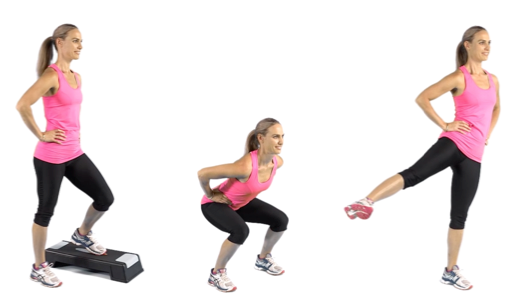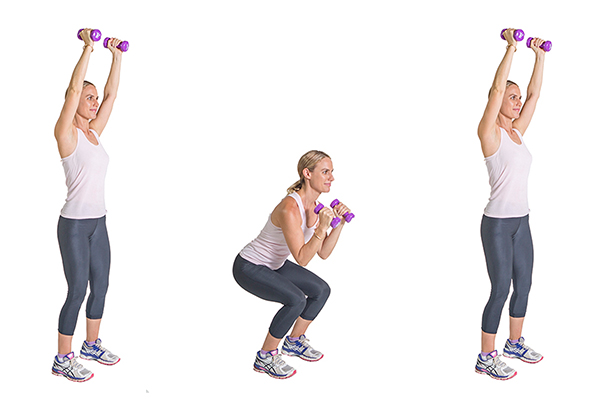For years, health enthusiasts have been pushing their boundaries of endurance hoping for weight loss results. However, exercisers who follow long, tiring exercise regimes in an effort to lose weight, may not be on the best paths to weight loss success.
In regards to weight loss, scientific research is now showing that steady state activities such as running and cycling, although excellent forms of exercise for increased health, may not be the activities that are going to contribute to dropping a dress size. Aerobic, steady state workouts may improve aerobic fitness but are not showing a large amount of weight loss when compared to anaerobic results.
Recent studies show that weight loss exercise programs consisting of moderate-intensity, steady-state exercise performed for approximately 30-40 minutes more than a few times per week, are resulting in only minimal fat loss.
Our 28 Day Weight Loss Challenge covers some of the most effective fat burning exercises and you can get a free exercise sampler by clicking here

In fact, according to the European Journal of Applied Physiology, the effects of cardiovascular or aerobic fitness performed for longer periods of time, may not only be reducing fat burning potential but may also actually encourage the body to store more energy. In turn, this increases the body’s fat reserves, hindering not helping the fitness enthusiast to lose unwanted body fat.
While many forms of exercise are regarded highly for living a healthy lifestyle, unless the person is extremely fit, certain types of exercises can actually increase the stress placed on the body, resulting in the release of hormones such as cortisol, which can control the body’s ability to lose fat.
Stress on the body
Cortisol is one of the hormones that are released when the body is placed under stress. Long duration and endurance activity such as long distance running may be more closely linked to chronic cortisol (a well-known cause of insulin resistance) and lead to the development of abdominal fat. Steady state exercises may also lead to food cravings for carbohydrate, creating an increased appetite post workout and a higher caloric intake.
It is also well documented that chronically high levels of cortisol may also cause an increased risk of health issues such as insomnia, digestive issues and depression. Research published in the journal of Hormone Research found that long distance running, such as endurance running, could potentially cause more insulin resistance, inflammation as well as increase recovery time and even reduce immune function. All of these factors are linked to the body’s fat burning potential.
In addition to this, studies show that performing cardiovascular activity for long periods of time may actually impair the production of the thyroid hormone T3, another hormone closely linked to thyroid function and metabolism. This is especially the case when partnered with reduced calorie intake, common among dieters.
So what is the best exercise to lose weight?
Short bursts of exercise with higher intensity are shown to be more beneficial in increasing metabolism and burning calories than those of longer duration. During short, higher intensity workouts the process of fat burning can last days, depending on the body’s response and the training session.
Our 28 Day Weight Loss Challenge covers some of the most effective fat burning exercises and you can get a free exercise sampler by clicking here

A recent study from the University of New South Wales in Australia showed that a group of people who performed short workouts of high intensity, with a total exercise commitment of only 60 minutes per week showed significant reductions in total body, abdominal, trunk and visceral fat. Fat burning in this group was far more efficient than those in the group who performed steady state exercises (longer duration jogging or cycling).
The short bursts of high intensity training also increased fat oxidisation in the aftermath (the body kept burning fat after the exercise had ceased) as a result of the body needing to replenish glycogen and remove lactate and hydrogen along with other metabolic factors. It was also found that high intensity training over steady state might have a suppressive effect on appetite.
Another study out of the University of Western Ontario, compared short but intense exercise to long, less-intense cardiovascular training. It was found that individuals who want to focus on reducing body fat should engage in high intensity, intermittent workouts between only 12 and 15 minutes long.
In the study, one group performed four to six 30-second sprint activities while the other group did cardiovascular exercise for 30 to 60 minutes. The results, despite the first group exercising for only a small portion of the time, those people performing the sprints burned more than twice as much body fat.
The high intensity sprints (anaerobic training) caused similar reactions in the body as those that occur during interval workouts or resistance training. The body is required to renew cells, replenish energy, convert lactic acid and restore hormone levels following a short intense workout. All of these processes occurring following the circuit attribute to the body burning greater amounts of fat.
When we are looking at losing weight (not maintaining fitness levels), running, jogging or cycling for long periods of time for weight loss may actually increase the body’s stress response, hinder recovery and reduce fat burning potential.
Re-developing training regimes from long steady-state exercises such as jogging, to shorter, higher-intensity workouts (Called HIIT and you will find this on the 28 Day Weight Loss Challenge may allow for greater fat burning potential, reduced stress on the body and a greater chance of sustainability and weight management.
For the most effective fat burning exercises get a free exercise sampler from our 28 Day Challenge by clicking here

How can I do this type of exercise
You can do this kind of HIIT exercise (High intensity interval training) on the 28 Day Weight Loss Challenge
Plus due to the short time bursts required it is PERFECT for busy mums and on the Challenge we combine this with pilates exercise routines too to really mix it up – all with videos.
HIIT Explained
High intensity interval training (HIIT) is fast becoming one of the best ways to burn body fat and increase overall fitness. It is often described as a workout that encompasses both intense bursts of effort and short fixed periods of recovery or reduced activity.
The magic of HIIT is in its efficiency and ability to achieve more in less time. It is a well known accelerant for metabolism as calories continue to burn long after exercise has ceased.
A recent Australian study showed females who followed a 20-minute HIIT program such as the one found in the 28 day weight loss challenge consisting of more than 5 second high intensity training lost up to six times more body fat than a group that followed a 40-minute cardio program performed at a constant intensity of 60% MHR.
The science also suggests that HIIT not only burns more calories (and body fat) than many other endurance activities, it also creates a dramatic improvement in exercise performance, despite the low exercise volume.
Even small amounts of HIIT training have shown significant improvements to VO2 max (a popular measure of endurance capability) and a 2012 study by Gibala, showed notable improvements following only six sessions of 2-3 minute HIIT, over a 2 week period.
So jump on the HIIT exercise bandwagon for maximum results.
Get your free exercise sampler from our 28 Day Challenge by clicking here

If you want to save money on household shopping bills and getting healthy then get our FREE guide to how you can save up to $150 in our FREE Free Budget Guide by entering your details below
Enter your details below for your free budget guide to save over $100 a week



